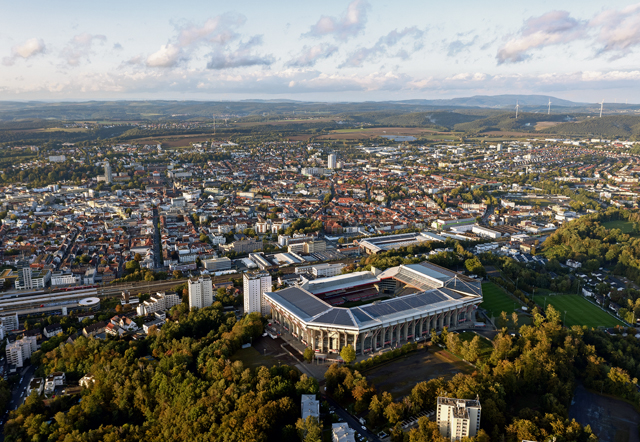
Many members of the Kaiserslautern Military Community have found temporary or even permanent homes in one of the many villages and towns surrounding Kaiserslautern in the heart of the Palatinate Forest.
Some members may be brand new and are just getting settled in, while others have already had the opportunity to get to know their home away from home. Let’s take a closer look and see what we can discover.
The County of Kaiserslautern stretches over an area of 639,980 square kilometers and has 108,540 inhabitants. The City of Kaiserslautern with a population of 101,480 is completely surrounded by the county. With roughly 50,000 Americans and NATO allies adding to the populace, commonly referred to as the Kaiserslautern Military Community, this amounts to 260,000 inhabitants in total.
U.S. military presence in the area amounts to a total economic impact of almost two billion U.S. dollars a year. This includes, but is not limited to, rents, utilities, construction, retail and services.
The County of Kaiserslautern is the most populous district in the Western Palatinate (Westpfalz). In its southern portion the Palatinate Forest determines the picture with Kaiserslautern being right in the center of the scene. The northern terrain is marked by hilly landscapes and the western area is known for its wet moorlands and soft rolling hills.
The City of Kaiserslautern is a municipality of its own and has a separate administration, but the county is divided into six individual union communities. These are administrative territorial communities, each composed of a group of individual towns or villages.
The largest union community, and with the highest American and NATO population, is Ramstein-Miesenbach. It has been home to Ramstein Air Base since 1952, which completely lies within its community boundaries.
Landstuhl is somewhat further south and not only provides space for Europe’s largest military hospital complex Landstuhl Regional Medical Center. It also has an astonishing Medieval history with its Nanstein Castle and has seen a famous emperor riding through its town center.
Enkenbach-Alsenborn and Hochspeyer, further to the north-east, has become home to many a service member throughout the last seven decades. It can look upon a diversified history of early settlers, a former U.S. air base, a maneuver site overgrown with heather, and even astonishing circus acts.
Otterbach-Otterberg to the west, is best known for its impressive Abteikirche (abbey church) and a delightful city center characterized by semi-timbered edifices built by the Walloons in the 17th century. It is also famous for its annual farmers’ market, culinary hikes in the summer and a sun dial.
Swinging back even further to the west, Weilerbach has a high American population, hosts an annual wine village in the summer and a Christmas village during the holiday season. It also has a rich history of Celtic life, waiting to be discovered.
Bruchmühlbach-Miesau is the union community furthest west and is characterized by great hiking trails, wetlands and an Army depot. It is also a renowned location for equestrian fans.
Two other counties that border Kaiserslautern County are officially part of the Kaiserslautern Military Community. Personnel stationed at Sembach may be surprised to learn that while they work at Sembach-Heuberg they are physically already in the neighboring county. The borderline of Donnersberg County runs almost straight through the guard shack, while Sembach village is still part of Kaiserslautern County. The most prominent landmark is Donnersberg as the highest peak in the region.
The County of Kusel, north-west of Ramstein Air Base, is a further neighbor and has become home to over 4,000 U.S. service members. The quaint town of Kusel offers leisurely strolls through town, a concert hall with excellent acoustics and neighboring castle Lichtenberg is well worth a visit, offering various Middle Age events throughout the year.
Kaiserslautern County offers a wide range of things to do and see, such as great hiking and biking trails and historic landmarks to explore from Celtic to Medieval sites. There is plenty of summer and winter fun, it offers shopping and leisure opportunities, and a chance to experience local culture, festivals and regional specialties.
The military in the region has enjoyed close ties to local civic leaders and the general populace for over seven decades. Three significant agencies have and will continue to promote mutual understanding and respectful neighborhood relationships.
The 86th Airlift Wing Host Nation Office is the main gateway to nearly all relations with the host nation and one of the two pillars of the relations with German leaders. It is the primary point of contact between host nation officials at local and state level and Air Force leadership. It also interacts directly with the local population and acts as an access point for inquiries and concerns by the German community.
Host Nation Advisors at the Public Affairs Offices both at the U.S. Army Garrison Rheinland-Pfalz and the 21st Theater Sustainment Command engage in promoting strong community and Germany-wide relations as well and have built bridges between changing military leadership and local representatives for over 70 years.
Each individual union community has a story of its own to tell. In the upcoming weeks, we will highlight one community at a time. Be open for discoveries in your village or town of residence, while we take you on an exciting journey through the County (and City) of Kaiserslautern. Stay tuned for a few surprises!


